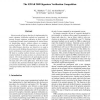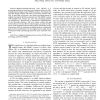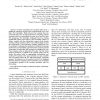612 search results - page 75 / 123 » Bridging the Gap between Systems Design |
ICDAR
2009
IEEE
13 years 5 months ago
2009
IEEE
Recent results of forgery detection by implementing biometric signature verification methods are promising. At present, forensic signature verification in daily casework is perfor...
CORR
2010
Springer
13 years 6 months ago
2010
Springer
—Signal-to-leakage-and-noise ratio (SLNR) is a promising criterion for linear precoder design in multi-user (MU) multiple-input multiple-output (MIMO) systems. It decouples the p...
CLUSTER
2009
IEEE
14 years 2 months ago
2009
IEEE
—Current leadership-class machines suffer from a significant imbalance between their computational power and their I/O bandwidth. While Moore’s law ensures that the computatio...
RTSS
2003
IEEE
14 years 27 days ago
2003
IEEE
Data caches are essential in modern processors, bridging the widening gap between main memory and processor speeds. However, they yield very complex performance models, which make...
ECRTS
2006
IEEE
14 years 1 months ago
2006
IEEE
Cache memories have been extensively used to bridge the gap between high speed processors and relatively slower main memories. However, they are sources of predictability problems...



